As you progress in your music studies, either through the use of a guitar, piano, or even a violin among others, you will encounter the term. By incorporating scales and arpeggios in your play, you will be adding complexity and color.
It comes from ‘arpeggiate’ – an Italian word arpeggiate that means ‘harp playing’ or ‘play on a harp’. A harpist would play individual arpeggiator midi notes by plucking the instrument strings one at a time, and this is where the name of the technique comes from.
You can play arpeggios not only on the harp but also on other types of instruments. It is an important aspect to gain mastery of various musical instruments, as well as playing different music genres. In this article, we will look at what it is, and its diverse aspects.
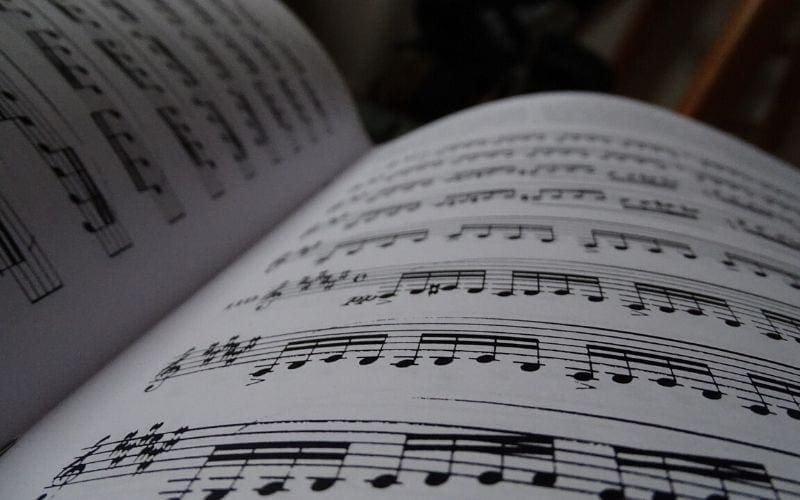
What Is An Arpeggio In Music?
The best definition is a broken chord. It comprises notes played in sequence rather than simultaneously.
Even though notes are neither sung nor played simultaneously, listeners often perceive the sequence of the notes as if producing a chord. Furthermore, when there are passing notes that are not considered the chord parts, such music excerpts may be analyzed differently by various music theorists.
What’s more, this technique is handy in enabling music composers who write for monographic instruments that deal with a single note at a time to voice chords, as well as the progression of chords.
How Does It Work?
Just like scales, it is an important aspect of music that you need to master. They are applicable in various music genres such as pop, classical music, metal, rock, blues, and jazz among others.
For instance, in music such as pop, guitar arpeggio serves as an accompaniment. Thus, rather than strumming or playing the chord notes simultaneously, you can play individual notes successively through a fingerpicking pattern (alternate picking). This is often on the acoustic guitar.
On the other hand, when it is used in genres such as blues, jazz, and metal, it serves as a soloing improvisation technique, rather than an accompaniment.
You can also play the jazz guitar arpeggio notes through a plectrum, and mute after each play to avoid simultaneous ringing (unless you are using the finger-style play). What’s more, this type doesn’t utilize chord shape.
What Does It Sound Like?
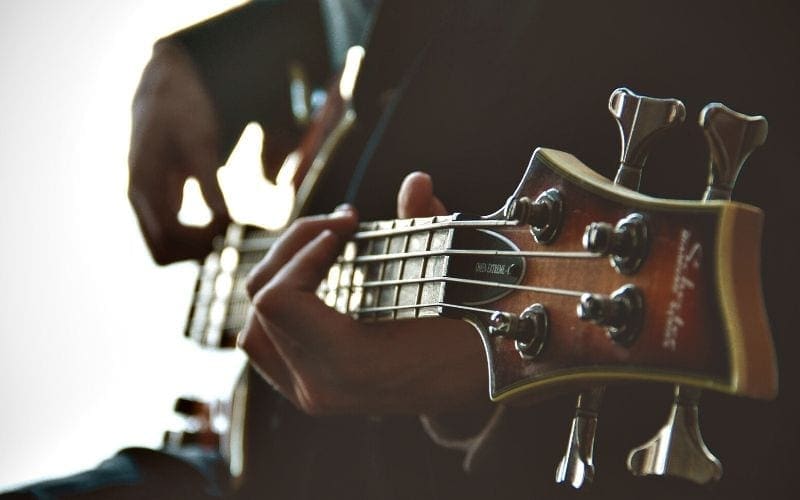
As mentioned earlier, it is a kind of chord that is broken, with notes being sung or played in either rising or descending order. Even though the notes are sung independently like in the case of the solfege syllabus, the sequence of the notes can be perceived as a chord.
In this case, it can be overwhelming for the brain to distinguish the individual notes. In such a case, the solfege syllabus is the best technique to understand what they sound like.
Arpaggiatic progressions rely on chosen notes of chords from different minor and major scales. So, let’s have a better understanding of major and minor Arpaggiatic progressions through solfege notations.
Major Arpeggios Progression In Solfege Notation
| 1 | 3 | 5 | 1 |
| Doh | Mi | Sol | High Doh |
Minor Arpeggios Progression In Solfege Notation
| 6 | 1 | 3 | 6 |
| Low la | Doh | Mi | La |
What Does An Arpeggio Look Like?
This comes with various shapes, just like scales. It is therefore important to take your time and master each one of them. On guitar, you can find each with 5-CAGED shapes.
So, let’s have a look at what CAGED shapes stands for:
Note: Before we start, it is important to note that there are different types and different types of CAGED shapes. We are going to focus on the most common major and minor shapes in this article.
CAGED Major Shapes For Guitar
C-shape Arpeggio
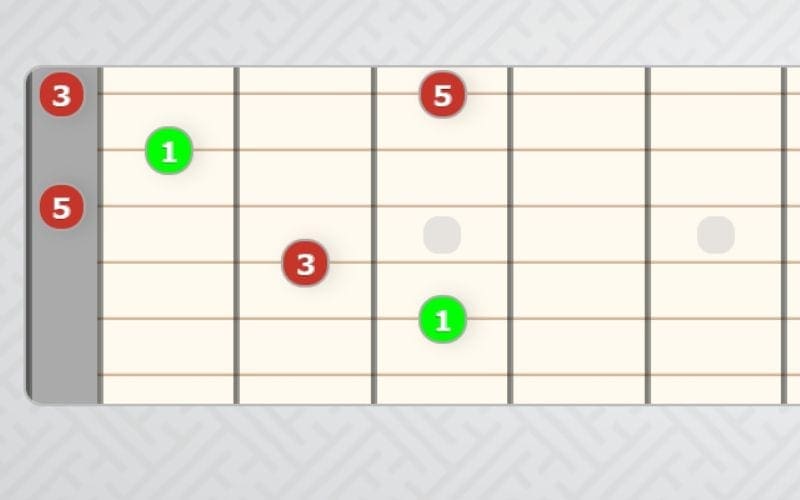
This shape is easy to learn and is a good one to start with when learning major arpeggios. You don’t need to learn all the shapes at once, just pick the ones that work for you and start using them in your playing.
This shape is easy to learn and is a good one to start with when learning major arpeggios. You don’t need to learn all the shapes at once, just pick the ones that work for you and start using them in your playing.
This shape is formulated from the C chord. The green dots represent the root, and the red dots are the other two chord tones. Start on the lowest note (green dot) and work your way up and down the. If you master this shape on the guitar, you can happily move up the guitar neck to play different arpeggios with the same shape.
The name of the arpeggio that you are playing will always be taken from the root note. So, if played in the open position, starting with the first green dot, you will be playing the C arpeggio. Move up one fret, and you will be playing C# major arpeggio. If you move up another fret, you will be playing the D arpeggio, etc.
When starting to learn this shape and moving up the guitar neck, don’t play the top string.
A-shape Arpeggio

The A-shape originates from the A-chord. If you are playing this in the open position, start on the second green dot on the second fret, and you will be playing A. As with the C shape, you can move the shape up the neck of the guitar.
Remember, as you move up the neck of the guitar, the name of the arpeggio will be based on the root note. So, if you start this by playing the first green dot on the second fret, you will be playing a B arpeggio.
G-shape Arpeggio
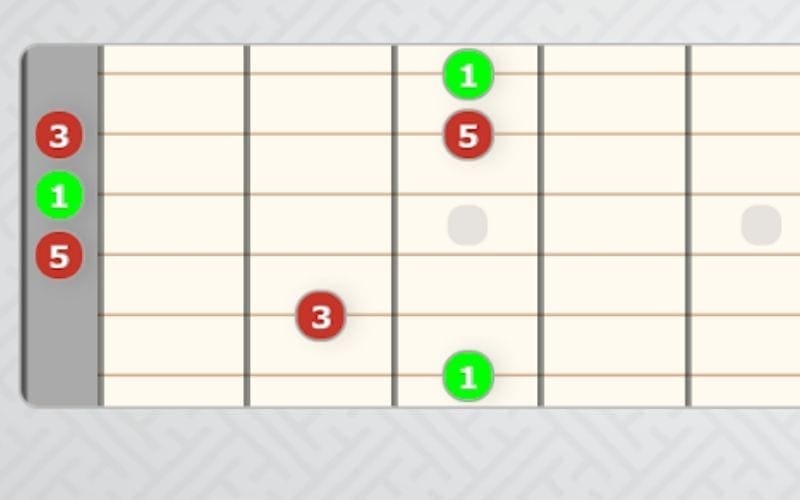
The G-shape arpeggio can be quite stretchy, but fairly good when it comes to mastering the guitar. If played in the open position, you will be playing the G arpeggio. If moved one fret, you will be playing G#. Up another will be playing the A arpeggio, etc.
E-shape Arpeggio
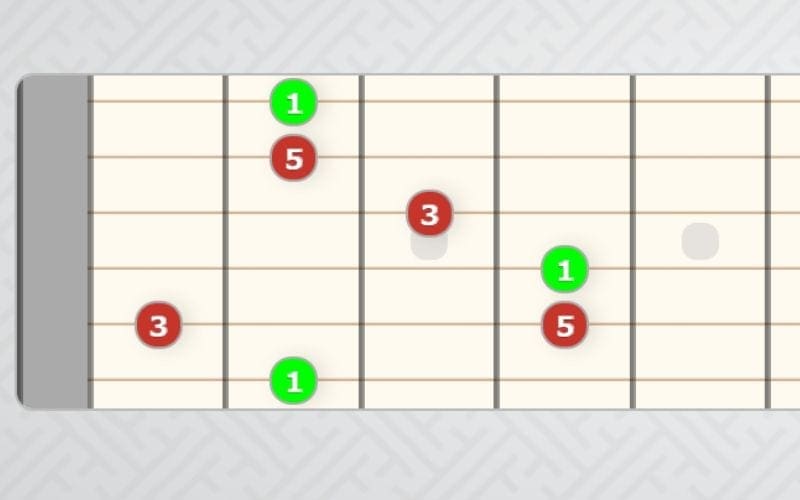
E-shape arises from E barred chord form. This shape is common in many kinds of music. It is fairly straightforward, and among the first that many beginners learn – especially when it comes to jazz and the blues.
Thus, the E-shape is very useful, and an excellent option to master well. Just like the A shape arpeggio, if you want to play an E arpeggio in the open position, you will need to start with the second green dot on fret 2. If you start with the first green dot on the second fret (as pictured), you will be playing an F#, since you take the name from the root note.
D-shape Arpeggio
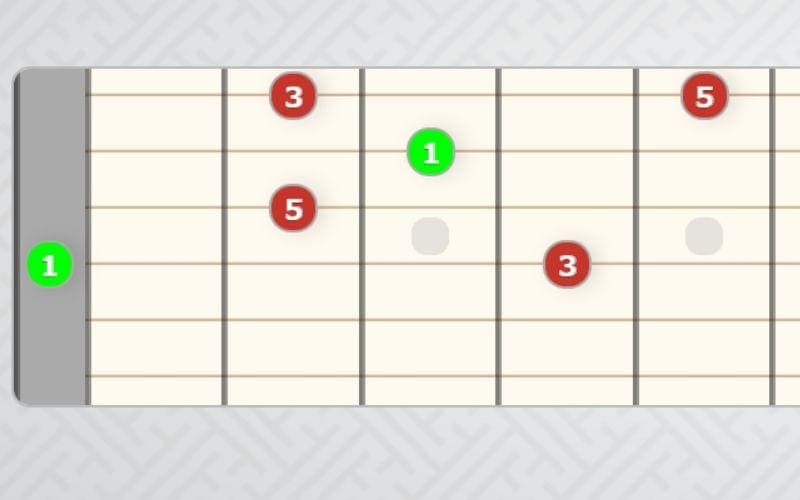
Now, this shape is a tricky one to grasp, however, with enough practice, you will get there. This shape is formulated from the D chord form. With this shape, it is important not to play the top two strings.
As with the other shapes, you can move up to the second fret, and you will be playing the E arpeggio. If moved up to the third fret, you will be playing the F arpeggio, etc.
CAGED Minor Shapes
The same concept described above can be applied to minor arpeggios. To get the minor shape, simply flatten the third note.
Cm- Shape
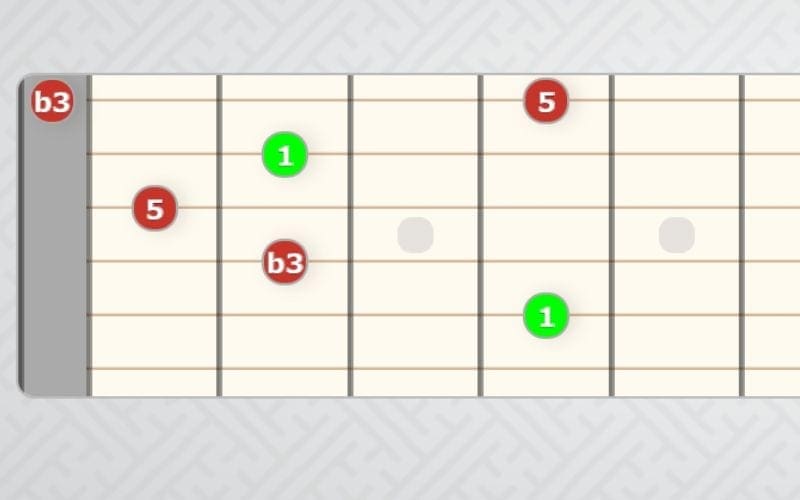
So, in the case of a C-shaped minor arpeggio, you simply flatten the third note (the E) and use the following pattern.
Am- Shape
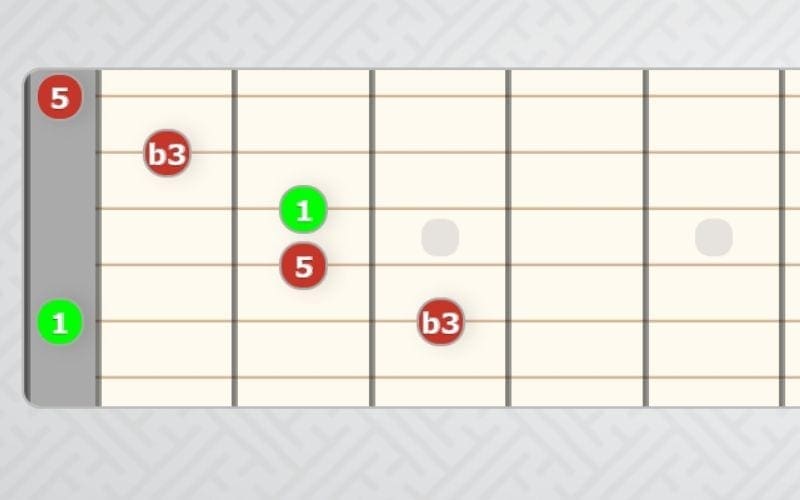
Gm- Shape
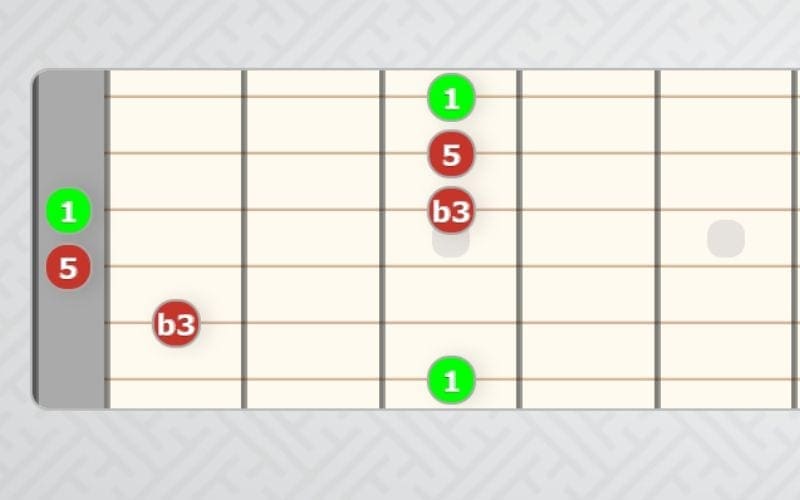
Em- Shape
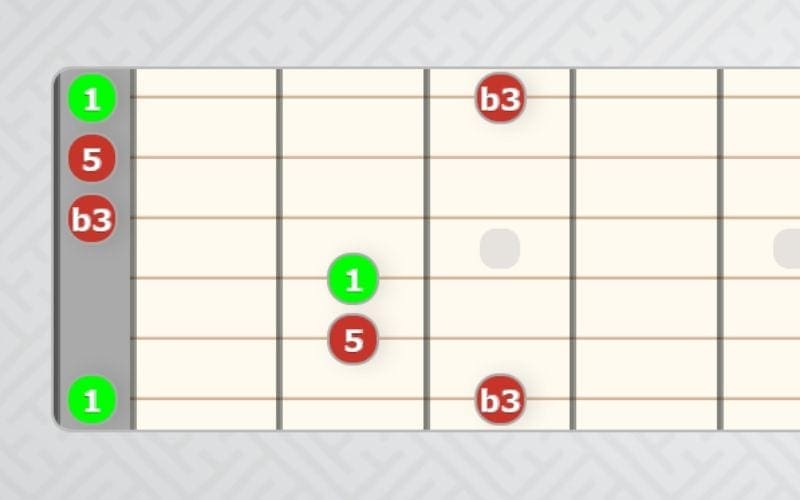
Dm- Shape
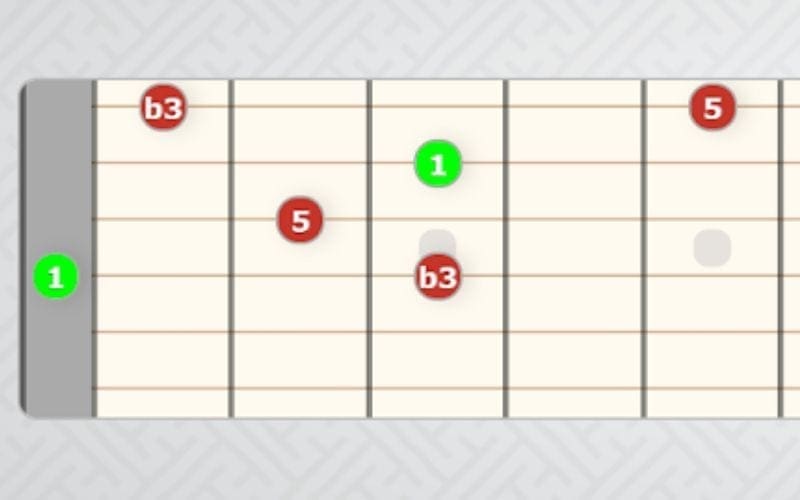
This is our final minor shape. The root of this shape is based on the fourth string.
When Should You Use Arpeggio When Writing A Song?
Arpeggio formulates a sound that is fast and flowing. Apart from being applied during a speed play, it also provides a boost to improvisation skills. Plus, since it comes with all of its chord notes, they are perfect in solos. In this case, you can link them to the chord structure below you to formulate cool-sounding clicks.
What’s more, they often sound great through their progressive matching chord. Thus, they create melodic bases as well as safe notes in general for guitarists’ improvisation.
What Are The Different Types Of Arpeggio?
Guitar Arpeggio
This is a guitar-playing technique that requires you to play notes of a chord a single at a time, as opposed to playing them simultaneously. For instance, the C major chord is composed of C, E, and G notes. Thus, when any of these notes are played one by one in any sequence, it can be termed a C-major arpeggio.
If you check on the scale of C-major notes, you will note C, E, and G as the first, third, and fifth scale degrees. Thus, this creates the chord formula, as well as the 135 arpeggio formula. Therefore, on a guitar, you can play the C major arpeggio as a 3-5-1-3 or 1-5-1-3 pattern through a finger-style as accompaniment.
You will also notice that many guitarists use arpeggios in certain types of music like neo-classical. In this case, sweep-picking is the mode of playing.
How To Use It
You can either use guitar arpeggio solely or through scale notes. By doing this, you can produce melodic lines, as well as indicate chord progression using individual notes. Because they are played through individual notes, the guitar notes often sound amazing through their chord matching in progression. Thus, there is a general form of safe notes (as well as home bases) that are melodic for guitarist improvisation. Additionally, it is handy in indicating harmony without the need for accompaniment chords during a solo guitar performance. So, every time you play guitar arpeggios, remember to switch arpeggio with the chord change, using the same technique you would apply in chord strumming.
What Is An Arpeggio In Piano?
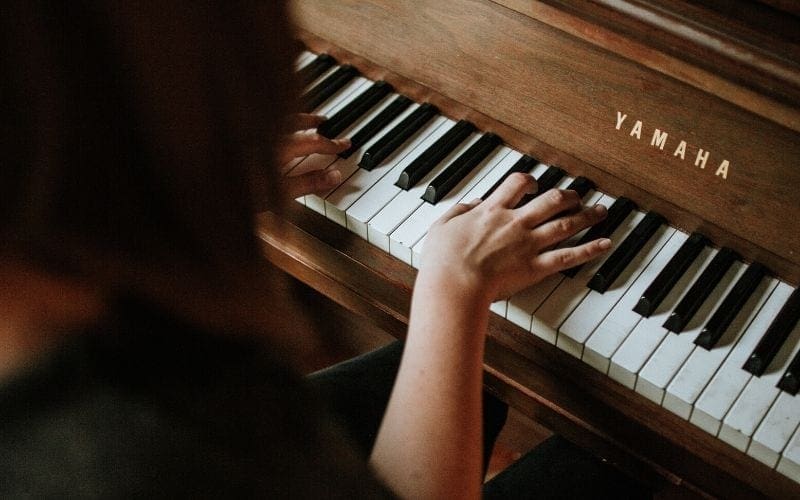
Arpeggio is essential to learn, especially if you want to be a piano master. They are fun and easy to grasp with little effort. With this technique at your figure tips, you will develop your skills and confidence in piano playing.
By learning piano arpeggio, you will boost your ear power, and the ability to identify patterns and intervals. So, every time you make a positive step during an arpeggio practice, it makes it easier for you to forecast the incoming note from a broken chord. It is also handy in building roots when it comes to melody creation.
Apart from improving your listening power, the piano arpeggio is handy in memory improvement as well as your playing speed. Thus, every time you practice over and over, you will be boosting your accuracy (as well as speed) in playing the individual notes. Arpeggios fill up the dead spaces that exist between the chords, thus producing an intriguing sound.
How To Use It
To gain the mastery of using arpeggio on piano, you must first:
- Have an understanding of what arpeggio is and how to use it, and its importance
- Have an understanding of how to write arpeggio in piano music
- Start practicing arpeggio using a piano
Bass Arpeggio
It is no secret that understanding arpeggio is a simple and quick route to building powerful bassline sounds. With this technique, it can create the difference between a dry sound and an intriguing song setting.
Therefore, if you are a beginner with a precise focus on creating powerful music, consider bass arpeggio courses. These courses will take your playing skills to a whole new level. Ensure that you understand the basic chords like basic musical intervals, minor keys, major keys, and triads among others first.
Furthermore, you need to be familiar with keys and chord properties. Lastly, ensure that you are aware of how chords can be built since arpeggio relies on the chord foundation.
Final Remarks
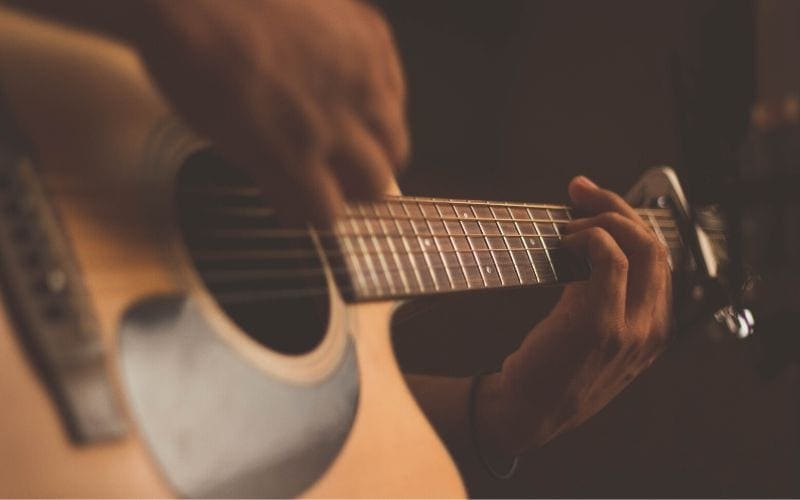
Even though it is important to master all shapes, being a master at one is much better than playing poorly in all five. Therefore, it is important to practice each shape at a time while moving back and forth.
With guitar arpeggio, you can add a little mood and color to your play. With 3note and 4note as the only variation, you can easily incorporate them without straining. However, learning and mastery of this technique require extra effort from you, and you will have to invest a bit of your time.
Take your time as you learn and implement to master the use of arpeggiator patterns and arpeggiated chords. During this time, use the tips of your finger to get every note right (play one note). As discussed earlier, always begin your practice with the lowest root note, as you learn each shape one by one.
Implement arpeggios into your practice and your playing, and why not get creative and write some songs yourself using them? For further information on chords, check out our article on chord inversions.









